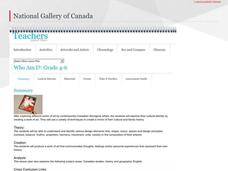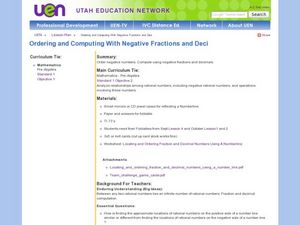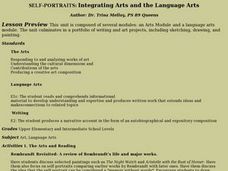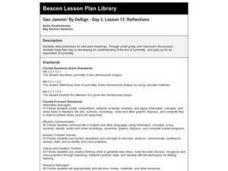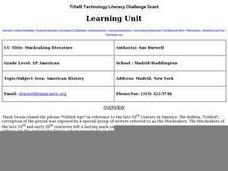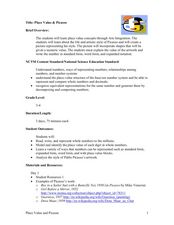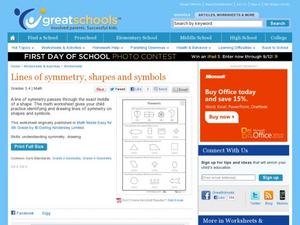National Gallery of Canada
Who Am I?
Connect design elements and principles to identity a culture with a discussion and related art activity. After analyzing artwork in relation to design, class members talk about personal and cultural identity. Using items that...
LearnEnglishFeelGood.com
Reflexive Pronouns
Use this 10-question grammar worksheet to assess, practice, or review reflexive pronouns where learners will read sentences and fill in the blank with the corresponding reflexive pronoun.
EngageNY
Grade 9 ELA Module 2: Unit 1, Lesson 6
It may not be 4 o'clock in the morning when you have ended these labors, but it's still time to work on textual analysis. Study the resolution of Edgar Allan Poe's "The Tell-Tale Heart" through the thematic lens of guilt and confession,...
Lions Clubs International Foundation
Mindful Self-Awareness Exercise: Identifying Feelings
Young scholars identify feelings through facial expressions and body language. Learners listen for a feeling word, then act it out and discuss how they portrayed it.
Curated OER
Symmetry
Students examine the concept of symmetry. They use photographs in front of a mirror to see symmetry. They write an explanation or drawing of how a mirror always produces a line of symmetry.
Curated OER
Ordering and Computing with Negative Fractions and Decimals
Seventh graders explore the concept of computing negative fractions and decimals. In this negative fractions and decimals lesson, 7th graders compare ordering positive fractions to ordering negative fractions. Students use mirrors to see...
Curated OER
Izzie's Igloo
Pupils must be phonemically aware to both read and write. This means that the student must understand phonemes and the relationship between letters and sounds. In this lesson, students work on the phoneme i=/i/. Since vowels are the...
Curated OER
Documentation: A Portrait and a Place
Seventh graders create a book entitled, "Who Am I?" They utilize art activities with related social studies writing assignments, and gather information from family sources.
Curated OER
Self-portraits: Integrating Arts And the Language Arts
Students look into a mirror and draw their own self-portraits. Then they write a descriptive essay, describing the portrait and the features of their face.
Curated OER
Geo Jammin' By DeSign - Day 3, Lesson 13: Reflections
Pupils use current knowledge to predict the meaning of line of symmetry. They explore symmetry using mirrors.
Curated OER
Muckraking Literature
Students complete a unit of lessons on Muckraking literature. They listen to and discuss a teacher-led discussion, read and analyze examples of Muckraking literature, conduct Internet research, and write a report on the attitudes of the...
Curated OER
Junie B. Packs Her Bags
In this Junie B. Jones vocabulary acquisition worksheet, students draw a suitcase in the blank space and write their word choices inside it to take to sleep over at Lucille's rich nana's house.
Curated OER
Rev. Dr Martin Luther King, Jr. meets the Philosophy of Gandhi's Ahimsa
Students study Gandhi's and Dr. King's philosophies. In this world history instructional activity, students compare and contrast the methods by Gandi and Dr. King writing an essay on nonviolence.
Curated OER
Coming to California
Fourth graders read excerpts from Juan Bautista de Anza's diaries. They analyze the impact of primary sources. They write journal entries for characters in stories they have read during the year.
Curated OER
What's Your Expression
First graders explore facial expressions in a mirror and create drawings of people with a facial expression of their choice. They graph the facial expressions drawn.
Curated OER
Tell Me All About It!!
Students discuss the importance of comprehension and the use of summarization. Through guided practice, they follow five steps in finding and highlighting important information, while deleting information that is not needed. Using the...
University of Minnesota
Try Angle
Does practice make perfect or just improvement? Scholars practice drawing a triangle on an Etch-A-Sketch. They learn about the part of the brain that controls sensory-motor integration and apply that to an analysis question.
Curated OER
Renaissance Man: Leonardo Da Vinci
Scientist, artist, inventor - was there anything Leonardo da Vinci couldn't do? Supplement your lecture on Leonardo da Vinci and the Renaissance with this presentation. Viewers will be surprised at how many modern scientific revelations...
E Reading Worksheets
Summarizing Text
Help learners find the most important information in a text with a lesson on summarizing. As kids read through a passage about Johannes Gutenberg, they summarize small excerpts, put events in sequential order, and respond to two longer...
Curated OER
Place Value & Picasso
Place value to the millions is the focus of this math lesson plan. Third and fourth graders investigate multiple ways to represent a number. They examine place value while studying factual information about Pablo Picasso. Resources are...
Curated OER
First World War Assessment
Here is a really neat assessment, perfect for middle schoolers who have just learned about WWI. The assessment covers the causes and effects of WWI, causes of WWII, the Treaty of Versailles, trench warfare, and key players of the war in...
Mathematics Vision Project
Module 6: Congruence, Construction, and Proof
Trace the links between a variety of math concepts in this far-reaching unit. Ideas that seem very different on the outset (like the distance formula and rigid transformations) come together in very natural and logical ways. This...
Curated OER
Aaaa! It's A!
Exercise phonemic awareness of the vowel /a/ to help children become successful readers. They connect spoken phonemes to written grapheme's and create a relationship between the vocal gesture of /a/ and its grapheme map in text and words.
Curated OER
Lines of Symmetry, Shapes and Symbols
Which shapes are symmetrical? Third graders decide which shapes have lines of symmetry, and which shapes are not symmetrical. They work on 13 shapes and symbols, four of which have lines already drawn through them. Use this resource to...
